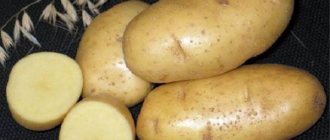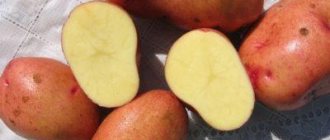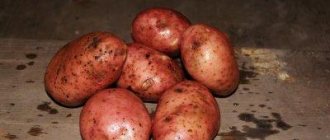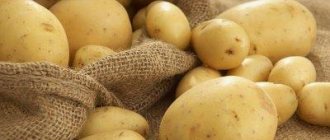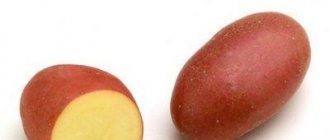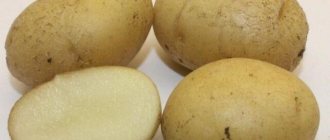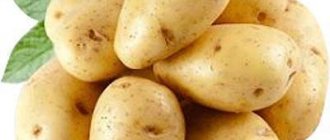Between the development of a new potato variety in 2007 by scientists at the All-Russian Research Institute of Potato Farming named after A.G. Lorch" and its inclusion in the State Register of the Russian Federation, seven years have passed. In 2014, the variety “Cornflower” was recommended for cultivation. “Vasilyok” was obtained by crossing two varieties of potatoes: “Chugunka” and the hybrid D-31-88.
Description of the variety Cornflower
| Variety name | cornflower |
| general characteristics | table variety from the Russian collection, with purple tubers |
| Maturation period | 80-100 days |
| Starch content | 12-16% |
| Weight of marketable tubers | 80-120 gr |
| Number of tubers in a bush | 9-14 |
| Productivity | 200-480 c/ha |
| Consumer qualities | suitable for dietary nutrition |
| Keeping quality | 96% |
| Peel color | violet |
| Flesh color | white |
| Preferred Growing Regions | Central |
| Disease resistance | susceptible to potato nematode, moderately resistant to viruses, late blight of tops and tubers, scab, resistant to potato cancer |
| Features of cultivation | standard agricultural technology |
| Originator | VNIIKH them. A.G. Lorkha (Russia) |
- Ripening time 70-90 days (medium early).
- Table variety.
- Used in dietary and baby food.
- Contains a large amount of vitamins C, E.
- The variety is especially valuable for the presence of carotenoids in the tubers.
Carotenoids are organic natural pigments formed during photosynthesis. They act as antioxidants in the human body.
Antioxidants normalize the functioning of the reproductive organs, skin, and mucous membranes. Protect the body from fungal and bacterial diseases.
- Culinary type VS. Designed for making soups, purees, boiling and frying.
- The taste is excellent.
- Average starch levels in the variety are 12.6-16%.
- The potential marketable yield of the variety is medium-high . The maximum achievement in the Moscow region is 182 centners of potatoes per hectare.
- Has excellent keeping quality, not lower than 96%.
- The marketability of the variety is 70-94%.
- Average sensitivity of the variety to mechanical stress.
According to clinical studies conducted in American clinics, eating purple potato dishes prevents the development of cancer , the formation of cholesterol plaques, strengthens blood vessels and supports the heart muscle.
In the table below you can get acquainted with such indicators as the keeping quality and yield of potatoes of different varieties:
| Variety name | Productivity | Keeping quality |
| cornflower | up to 180 c/ha | 96% |
| Bullfinch | 180-270 c/ha | 95% |
| Rosara | 350-400 c/ha | 97% |
| Molly | 390-450 c/ha | 82% |
| Luck | 420-430 c/ha | 88-97% |
| Latona | up to 460 c/ha | 90% (assuming there is no condensation in the storage) |
| Kamensky | 500-550 | 97% (early germination at storage temperatures above +3°C) |
| Impala | 180-360 | 95% |
| Timo | up to 380 c/ha | 96%, but the tubers germinate early |
Potatoes of this variety keep well. Read more about timing, temperature and storage problems. And also about how to store root vegetables in winter, on the balcony, in boxes, in the refrigerator, peeled.
Collection, storage and use of crops
Providing good conditions for plants, using high-quality seed and fertilizers is the key to obtaining a high yield. It is collected in late summer or early autumn.
Cornflower potatoes can be stored for 3 to 4 months. In conditions of high humidity there is a risk of tubers sprouting.
A dry place out of direct sunlight is suitable for storage. It is important to ensure good air circulation and temperature conditions not exceeding +3°C.
Potatoes of this variety have pleasant taste characteristics. It is eaten boiled, fried and baked.
Characteristics
- Bush of medium height, intermediate semi-erect type.
- The open, dark green leaves are medium in size. The tops are strong, rich green in color;
- Corolla of small red-violet or bluish-violet flowers;
- Anthocyanin coloration on the inside is weak to medium.
Anthocyanins are natural coloring substances. Flowers, peel and pulp of fruits are colored blue, purple, and red. - The peel is glossy, distinct purple in color, very beautiful.
- The average weight of a marketable tuber is 77-115g. One bush brings up to 15 tubers.
- The pulp is white, creamy when cut. The consistency is dense, soft, medium mealy and watery.
- When heat treated, the purple color of the peel disappears.
- The eyes are small and superficial.
- The seed material is dark brown with a blue tint. Sprouts of rich purple color.
You can compare this indicator of the number of tubers with that of other varieties using the table below:
| Variety name | Number of tubers in a bush |
| cornflower | up to 15 |
| Jelly | up to 15 |
| Typhoon | 6-10 pieces |
| Lily | 8-15 pieces |
| Tiras | 9-12 pieces |
| Elizabeth | to 10 |
| Vega | 8-10 pieces |
| Romano | 8-9 pieces |
| Gypsy | 6-14 pieces |
| Kolobok | 15-18 pieces |
Features of cultivation and care in open ground
Potatoes are fairly easy to plant; It is also distinguished by its ease of care, which makes the planting process quite simple. But at the same time, special attention must be paid to the selection of seed material and its preparation. In addition, soil fertilization is an important point, as this will directly affect potato yields in the future.
Optimal timing and conditions for planting
Planting is carried out at the moment when the night frosts pass. This could be mid or late March, depending on the climate.
Learn how to prepare potatoes for planting.
Potatoes prefer illuminated areas of the ground that are well protected from the wind. The soil requirements are small, the only thing is that the soil must be non-acidic, otherwise the variety will not produce a bountiful harvest. If the soil is very heavy, a lot of organic fertilizer must be added to it when preparing the holes.
On swampy or peaty soils, the variety will bear fruit only after mandatory crop rotation and reclamation. The soil itself should be dug up twice before planting the seedlings.
Important! Planting of potatoes of this variety can only be carried out if the rules of crop rotation are observed - the variety is planted after growing a variety of root crops, cucumbers, cabbage, legumes or pumpkin crops.
Preparation of planting material and planting scheme
It is very important to choose the right planting material. Due to the possibility of rot, it is important to select healthy and dense tubers, without signs of infection. Since they germinate quickly, it is important to adhere to the rules for storing the crop - it is advisable that it lies in cool places and in the dark. Dry basements or pantries are ideal.
Around February, the tubers are taken out and laid in one layer so that they begin to germinate. You can speed up this process by sprinkling them with sawdust and spraying them regularly with a spray bottle.
Before planting, the tubers are also necessarily disinfected to prevent the appearance of late blight during growth (sprayed with solutions containing copper).
The planting scheme is quite simple and depends on the size of the tubers themselves. You can use the following standard patterns: 70 by 20 centimeters or 60 by 30 (sometimes 25 if the tubers are small).
That is, standard planting schemes are used, where the length of the bed can be 60 or 70 centimeters, and the distance between tubers varies from 20 to 30 centimeters.
Tubers are planted with their buds facing up to germinate faster. The depth is determined by the density of the soil - from 10-12 cm on light soils to 4-5 cm on clay soils.
Frequency of watering and fertilization
Fertilizing and watering greatly affect the fertility and quantity of the crop. To obtain maximum performance, it is necessary to fertilize regularly, since Cornflower loves fertile soil. The first application of fertilizers is carried out before flowering (only on well-moistened soil).
Fertilizer is added directly to the root. The interval between applications is approximately one and a half weeks. Chicken droppings, urea and manure are suitable as fertilizers.
Learn how to water potatoes correctly.
Watering before flowering begins is carried out as necessary (only if the weather is very dry or hot). As soon as the flowering period begins, you need to start active watering , since at this moment tubers begin to form.
Watering is carried out mainly in the evening or in cloudy weather three times a week, and if the weather is hot, then every day. Afterwards, the earth is necessarily loosened, and the bushes are hilled up.
Important! Sprayers should not be used for watering. Moisture on the tops can cause late blight. Water flows only at the root.
Weed control
Mulching also affects yields. Removing weeds guarantees an increase in yield. It is not recommended to use coniferous raw materials for mulching, as they oxidize the soil, and this variety does not tolerate acidic soils very well.
During the growing season, the bushes are hilled about three times. The procedure must be repeated until the gaps between the mounds disappear.
Photo
The photo shows the Cornflower potato variety:
Photo: Natalya Smirnova, the editors thank you for permission to use the photo.
Farmer reviews
Although the Cornflower variety is new, it has many positive reviews from farmers and gardeners.
Tatyana, Ryazan: “Cornflower is similar to the Blue Danube and Tsyganka varieties. A little small, but there are a lot of potatoes in the bush. Disadvantage: affected by scab.”
Irina, Kursk: “I planted Cornflower, Golubizna, Kolobok and Charodey on the plantation. Cornflower gave the largest harvest (0.5 kg yielded 12–15 kg). I don’t really like that the variety gets a little soft when cooked.”
Nina, Nizhny Novgorod: “Cornflower potatoes do not like overly alkaline or acidic soil. To determine if the soil acidity is suitable for growing this variety, pay attention to the weeds growing in the area. If dandelions with coltsfoot and wheatgrass bloom profusely on the plantation, you can safely plant Cornflower. It will feel great in such land and will produce a good harvest.”
Disease resistance
- High degree of resistance of the variety to late blight of leaves and tubers, potato cancer;
- Not susceptible to wrinkled rot, banded mosaic;
- Weakly affected by ring rot, dry rot, and common scab;
- The variety is susceptible to potato cyst nematode.
Advantages and disadvantages
The variety has a lot of advantages, but it is worth noting its disadvantages.
| pros | Minuses |
| Relatively good yield | Tendency to form ring and dry rot |
| Great taste | Requirements for storage conditions |
| Resistant to many diseases | Difficult to clean due to the dark and thin shell |
| Excellent tuber quality | |
| A large amount of useful substances, including vitamin C | |
| Good keeping quality | |
| Ease of hilling | |
| Tolerates transportation well |
Features of potatoes
The elastic tubers, uniform in shape and size, are convenient for harvesting and storage. The presence of carotenoids can be noted.
Origin
Potato Vasily is the fruit of five years of work by Russian scientists. It was obtained by crossing the Chugunka variety and the hybrid D-31-88. Registered in the register of the Russian Federation as a selection achievement in 2014 under No. 9253214.
The developer, originator, and patent holder of the Vasilek potato variety is the All-Russian Research Institute of Potato Farming (VNIIKH) named after. A. G. Lorch of the Russian Agricultural Academy.
The variety is recommended for cultivation in the Central, Central Black Earth, and Northwestern regions of Russia on private farms.
Research has shown that colored tubers absorb less nitrates than traditionally colored varieties. At the same time, the percentage of starch and proteins does not decrease and the saturation of vitamins is increased.
Two medium colored potatoes contain as much vitamin C as one lemon.
Advantages and disadvantages of the variety
Among the advantages of the Cornflower variety:
- the possibility of obtaining a harvest 70 days after planting;
- no need for frequent hilling due to the compactness of the bush;
- high yield;
- resistance to diseases and pests;
- high content of vitamins, antioxidant properties;
- pleasant taste.
Among the few disadvantages are:
- plant susceptibility to nematodes and rot pathogens;
- rapid germination of tubers, making it difficult to store the crop in winter;
- in acidic soil conditions the variety does not produce a good harvest.
For which regions is it best suited?
Breeders developed the Cornflower variety for cultivation in the central part of Russia. Plants feel good throughout the country, except for its northern part. The culture is undemanding to soil and climate.
The maximum yield is achieved when grown on light, fertile soil in the climatic conditions of the central regions.
Agricultural technology
Agricultural technology for growing Cornflower potatoes includes several main points.
Seed selection
To prevent potato nematode diseases, it is important to prepare high-quality seed material .
- For planting, healthy, smooth tubers without growths or damage weighing 50-75 g are selected;
- Spray the tubers with an aqueous solution of copper sulfate (a tablespoon per bucket of water);
- Dry, lay out in the light in one layer for germination.
Soil and site
Potato variety Cornflower prefers sunny areas, protected from strong draft winds. To provide the seedlings with optimal temperature and breathable conditions, the soil for planting is dug up twice - in autumn and spring.
To make heavy soils suitable for growing Cornflower potatoes, a lot of organic matter is added to them.
In swampy-peaty soils, the variety produces a harvest only after cultivation and reclamation work has been carried out.
Follow the rule of crop rotation. The variety is planted after growing green manure, root crops, cabbage, cucumbers, pumpkin and legumes.
Seed material, depending on the weight of the tubers, is planted according to the following schemes: 70x20 cm, 60x25 cm, 60x30 cm.
Green manures are plants that improve the quality and structure of the soil, enriching it with nutrients and organic substances. The most suitable green manures for potatoes are alfalfa, peas, vetch, and sweet clover.
Care instructions
- On days 14-15 after planting, the row spacing is loosened to a depth of 8 cm;
- When the tops reach a height of 15 cm, the first hilling is carried out. After the disappearance of the gaps between the overgrown bushes - the second;
- In dry weather, three waterings are required during the active growth period. Consumption of up to 3 liters of water per bush;
- Weed or mulch regularly.
Agrotechnical rules
If we consider the Cornflower variety from an agrotechnical point of view, it is a fairly easy-to-grow potato that does not require special knowledge or special attention from the summer resident. However, if you carry out planting work correctly and take good care of Cornflower, then it will respond to all this with a good harvest.
Basic agrotechnical rules for growing potatoes:
- The quality of the harvest will depend on the quality of planting material. Therefore, only healthy tubers are allowed for planting. They should not be covered with stains, cracks, growths or insect holes. Experienced summer residents recommend treating root crops with special pesticides before planting to prevent possible invasion by insects or fungal diseases.
- In the fall, after harvesting, it is necessary to prepare the soil. To do this, weeds are completely removed from the site, it is plowed/dug up and fertilizer is applied.
- Tubers can only be planted in well-warmed soil. The ideal soil temperature for planting is +8-10 degrees Celsius. At lower soil temperatures, the crop will develop very poorly and there is a risk of death of the seed material.
- Potatoes should not be planted too crowded. The ideal distance between rows is 70 cm, between holes 35-40 cm. The larger the row spacing, the better the aeration and illumination of the bushes. Also, the greater the distance between the rows, the easier it is to hill up the bushes.
- You need to pay special attention to watering. Cornflower is not a demanding variety, but it needs to be watered at least three times during the season. The first time is when the first shoots appear (grow up to 10 cm). The second time in the active flowering phase. After the flowers appear, 2-3 liters of water are consumed per 1 potato bush. And the last watering is carried out immediately after flowering. Since Cornflower is a mid-season variety, it is not watered after flowering in order to protect the crop from possible late blight invasion.
- It is imperative to carry out hilling. Firstly, if you do not hill up the potatoes, you can lose 20-30% of the harvest, since additional stolons are not formed. Secondly, during hilling, weeds are removed and the soil is loosened.
Prevention of diseases and feeding
In order to prevent late blight, the variety is treated with copper-containing preparations three times during the growing season.
As for fertilizers, after planting they are fed with a 10% solution of bird droppings, a solution of urea (a tablespoon per bucket of water), manure (a liter jar of manure per bucket of water), and herbal infusions.
Read more about how to feed potatoes, when and how to apply fertilizers, and how to do it correctly when planting.
To combat Colorado potato beetles and fertilize, place a handful of wood ash mixed with soil into the holes during planting.
To destroy larvae and beetles, ash-wormwood tincture is used.
- Grind 3-4 handfuls of fresh wormwood;
- Pour boiling water over;
- Add a glass of ash;
- Stir, let it brew for 3-4 hours, filter;
- Spray in the morning or evening.
In addition to fertilizers, other preparations and chemicals are often used when growing potatoes. We bring to your attention useful articles about the benefits and harms of fungicides and herbicides.
Despite the young age of Cornflower potatoes, they are already loved for their taste , dietary properties and beauty of the tuber . It continues the color line of the popular blue and purple varieties.
Planting and cleaning
The soil for planting potatoes is prepared in the fall: they dig up the ground, get rid of weeds, and apply organic fertilizers in the form of humus or compost. The area for root crops is selected following the rules of crop rotation.
The best predecessors of culture will be:
- legumes;
- green manure;
- cabbage;
- onion;
- beet;
- cucumber;
- zucchini;
- garlic.
In the spring, the soil is fed again, but with mineral fertilizers, loosened, and weeds are removed. If it is loamy, then add sand or peat to lighten it. Slaked lime or dolomite flour is added to acidic soil.
Medium-sized tubers, without signs of disease or mechanical damage, are selected for planting. Place them in a bright room and let them germinate. The day before planting, I treat the seeds with disinfectants against diseases and pests and growth stimulants.
For planting, holes are made 10 cm deep at a distance of 30 cm from each other, the distance between the rows should be 60-70 cm. Ash and nitrophoska are placed in the holes, onion peels are added to repel insects, potatoes are placed and covered with earth.
The soil for planting should be warmed to 10-12 °C.
You can tell that it’s time to harvest the potatoes by completely dry tops. The maturity of the root crop is determined by the peel: it must be dense enough to withstand pressure.
Potatoes are harvested in dry weather. The harvested crop is thoroughly dried, spread between the beds or under a canopy.
Useful video
In the table below you will find links to materials about potatoes with different ripening periods:
| Mid-season | Mid-early | Mid-late |
| Santana | Tiras | Melody |
| Desiree | Elizabeth | Lorch |
| Openwork | Vega | Margarita |
| Purple Haze | Romano | Son |
| Yanka | Lugovskoy | Lasunok |
| Tuscany | Tuleevsky | Aurora |
| Giant | Manifesto | Zhuravinka |
How to care
At an early stage of development for Cornflower potatoes, it is extremely important to loosen and weed the soil after each watering or rain. This will preserve nutritional components in the soil and air access to the roots, which will have a beneficial effect on the development of the bushes. The variety easily tolerates short-term drought, but with a long-term lack of moisture in the soil it needs watering with soil wetting by 10 cm.
When the potato tops reach a height of 17 cm, you need to carry out the first hilling, and the second at the stage of closing the bushes. The Cornflower variety responds well to fertilizing. During the active growing season, it is recommended to use urea 30 g per 10 liters of water or mullein 1:10. The second feeding should be done before the bushes flower. At this time, you can use nitroammophoska in the proportion of 1 tbsp. l. on a bucket of water. It is recommended to apply fertilizer for the last time after flowering. At this stage, you need to use superphosphate 30 g and potassium sulfide 25 g per 10 liters of water.
Important! Starting from the second half of June, it is impossible to use organic matter and nitrogen fertilizers, as this stimulates the development of bushes to the detriment of the formation of tubers.
Cornflower potatoes need to be weeded regularly until the bushes close.
Appearance of tubers and tops
Potato cornflower tubers
The bushes grow medium in size and height, semi-straight. The tops have a particularly bright green color and a special strength. The leaves on the bushes are medium-sized, dark green, the flowers are small - reddish or purple. The tubers have an elongated oval shape, a smooth surface, with small eyes on the peel.
A distinctive feature of potatoes is the color of their skin - it is very unusual, compared to other varieties, of a dark blue-violet color. Thanks to him, the variety got its name. The plant's sprouts are also dark blue.
Did you know? Although potatoes are considered filling and nutritious, not a dietary product, an average potato weighing about 100 g contains only 76 calories.
The potato flesh is cream-colored. The average tuber weight can vary from 75 to 110 grams. The growing season is from 80 to 100 days.
